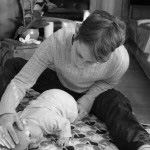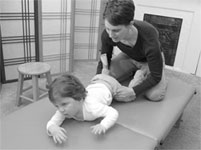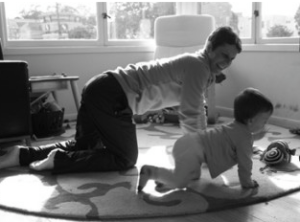Dear Students:
The previous post, Crawling Isn’t Only for Babies, brought forth the question: “What do you suggest parents can do to help a baby crawl & walk on schedule?”
There is so much to say about this subject but I will give you my best short answer. Typically developing babies do not need help in learning how to crawl  & walk if care givers stay out of their way. When you understand that newborns will instinctively press & push their bodies into any surface they feel, you can make sure it is one that can lead to bigger movements. Babies that spend time exploring on a hard ground can eventually learn how to move upon it. This can occur easily if an infant is lying on a floor but not on a soft mattress or sofa or while confined in a contraption.
& walk if care givers stay out of their way. When you understand that newborns will instinctively press & push their bodies into any surface they feel, you can make sure it is one that can lead to bigger movements. Babies that spend time exploring on a hard ground can eventually learn how to move upon it. This can occur easily if an infant is lying on a floor but not on a soft mattress or sofa or while confined in a contraption.
The development movements that babies go through when given the opportunities to move, lead to well organized independent sitting, standing & walking that gives them the choice to rest when they want. Tots can easily get  hurt if they are placed in a “baby seat, door jumper or walker” before they can roll into sitting or climb to standing on their own. Trying to hold themselves upright with under-developed muscles & bones can become exhausting & painful. With that thought, I give care givers 3 suggestions to follow so they can become aware of when they are helping or hindering a child’s motor development.
hurt if they are placed in a “baby seat, door jumper or walker” before they can roll into sitting or climb to standing on their own. Trying to hold themselves upright with under-developed muscles & bones can become exhausting & painful. With that thought, I give care givers 3 suggestions to follow so they can become aware of when they are helping or hindering a child’s motor development.
Tips for Caregivers to Enhance a Baby’s Motor Development: 1. Car Seats Are For Cars Only: A car seat is designed to contain a baby inside it, in case of an accident. Knowing this, parents ought to be sure to carry children in their arms to & from the car so they can move & snuggle with them as they are transferred. Avoid using the car seat as a baby-sitter or for nap time as it prevents infants from moving. Children will instinctively push against a car seat & over long periods of time may become tired & loose the desire to try to move. During sleep the nervous system processes all the initiated movements of the day. As a result babies may carry out new motions if they are lying on a floor or in a crib during each nap. 2. Eliminate Screen Time & Noise Cancellation Ear Phones: Kids that use cell phones, i-pads, computers & ear phones can fall into a trance-like state of mind that can become addictive & robs them of relating to others & the natural world. Eyes & ears develop naturally while outdoors.Screen time use can lead to attention deficit disorders, frustration, anger, temper tantrums, etc. Noise cancellation ear phones can cause a baby to loose the ability to filter out sounds when engaging in conversation in public places. I highly recommend not to use these devices with or around children as I believe they are detrimental to their present and future growth & development. 3.No Standing, Sitting, or Jumping Products Needed: Infants need to form knee caps, hip sockets, strong bones & muscles by bearing weight through their arms & legs as they roll, creep & crawl. During this process their joints become strong, flexible & stable. When babies sit, stand or jump too early while in “baby seats, bouncers or walkers” during their development it can lead to physical injuries such as hip dysplasia. Tots grow stronger & smarter each time they climb to standing, take a few steps, fall down & get back up again, without any assistance.
If your child is developmentally behind schedule or has special needs you can find a Feldenkrais and/or Child’Space Practitioner to help assist you with your child’s progress. In this video, I help a new mom, Marie understand the difference between “tummy time” and transitioning time. Watch & see how I taught this mom to roll her daughter from her back to her belly during this Child’Space session.
If you are not sure if you are helping or hindering a child’s motor development think of this scenario from my childhood. When I was 2 years old & my baby brother was a few months old our family got a puppy. Immediately my brother’s world began revolving around our dog, Gigi. Where ever Gigi went, my brother was sure to follow. He needed no toys to motivate him to move as he was always striving to keep up with Gigi. I always knew I could find them playing under a table or in the tunnel that was  created between the wall & the back of our couch. Think about how his experiences of relating to his canine friend shaped him physically, mentally & emotionally.
created between the wall & the back of our couch. Think about how his experiences of relating to his canine friend shaped him physically, mentally & emotionally.
Not only did my brother’s development benefit from our puppy but so did mine. As a toddler I was more interested in spending time on the floor crawling around with Gigi & my brother instead of trying to walk like the adults. I am so grateful for the benefits I received from this 2nd period of infancy as I believe it is one of the reasons I appreciate the Feldenkrais Method so much! Peace!
~Donna
Contact Donna Bervinchak at: